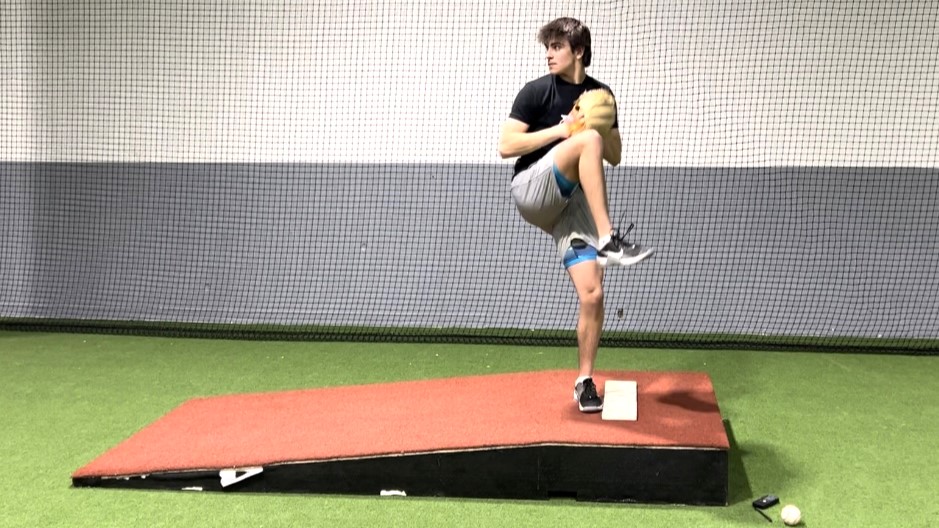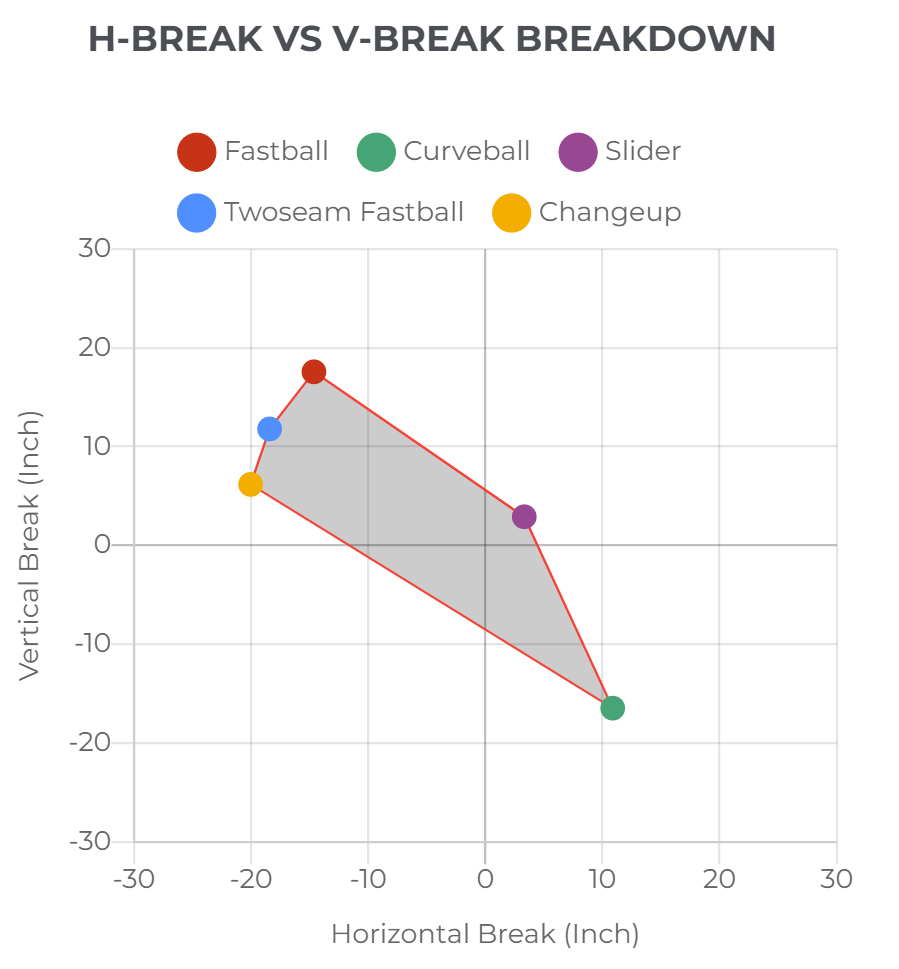
Lefty pitcher Antonio Doganiero (Class 2024), came to us for remote training through the Baseball U Anthracite travel program in Pennsylvania, this past October after a recent commitment to the University of Pittsburgh baseball program. He was looking to improve his overall performance on the mound. When Antonio started his remote program (6′ – 167 lbs.) he was sitting 83-84 mph. This past weekend, Antonio was sitting 86-88, and he touched 89.3 mph. There is obviously much more to come here. But, how did we do this on a remote basis in 4-5 months?
Remote Training Process
Before we dive into Antonio’s training blueprint… let’s talk about what the remote process entailed.
-
- Each month, Antonio was given an individualized mobility, strength, and throwing program
- Each month, the programs were linearly progressed as we got closer to the season
- At the beginning of every month we would meet via a zoom call to go over the monthly plan and iron out any questions, comments, or concerns he may have had
- Throughout this remote process communication with Antonio remained constant and we spoke on a weekly basis:
- Going over video of mechanical corrective exercises
- Going over video of form for various exercises in the weight room
- Touching base on how he was feeling regarding his progress
- Addressing questions or concerns he may have had in regard to his programming
Now… lets dive into what we aimed to work on this off-season.
Lean Body Mass
Lean muscle mass has one of the highest correlations to velocity as well as injury prevention. At 6′ – 167 lbs., Antonio’s lowest hanging fruit was putting on another 10-15 lbs. of lean muscle mass. This included educating the athlete on proper nutrition and “clean” calorie consumption. Adding lean muscle mass was priority #1. Training 5x / week puts significant added pressure on the body to increase caloric intake. If you’re interested in adding lean muscle mass you need to eat (here’s a guide if interested). There is no way around it.
Improving Mobility/Strength
Mobility – Trying to improve throwing mechanics with drill work without first improving the athlete’s movement patterns is only teaching the athlete to move inefficiently. So next on the agenda was addressing mobility and strength in all the right places.
We assessed Antonio’s active and passive ROM through our comprehensive movement assessment, and were able to find the following issues to help better address his overall movement and athleticism on the mound:
-
- Increasing core control
- Increasing hip mobility/stability
- Increasing posterior cuff strength
- Increasing adductor strength
Strength – Assessing strength in the weight room with the “Big 3” lifts let us know if there is a strength deficit or if the athlete is “strong enough”, in which case lighter loads would be prescribed to help train for power.
From the strength assessment, Antonio’s posterior chain strength and upper body strength were pretty good, so the main thing we needed to address was improving his numbers with the squat lift.
-
- Lower body strength (2x bodyweight)
- Est. 1RM
- Deadlift – 375 (good)
- Squat – 238
- Upper body strength (1x body weight)
- Est. 1RM
- Bench press – 200 (good)
- Lower body strength (2x bodyweight)

Addressing Mechanical Disconnects
Although Antonio is a remote client, given his proximity (PA to NJ) he chose to come in-house for a motion capture / video assessment. A thorough review of his mechanics with both video and mocap allowed us to dig deep into his delivery and pursue specific adjustments we could make. Here he is on the mocap system.
From the mechanical eval report, some of the main topics that we felt needed to be addressed were:
-
- Weight shift leading to better glute engagement and timing – The momentum created by the drift allows for better timing and engagement of the glutes and aids in applying force more laterally and vertically.
- Early heel/ rotation – When a pitcher loses connection with the ground too early, they are most likely leaking kinetic energy and therefore not efficiently maximizing their potential throughout the throw. By maintaining connection with the ground, the kinetic energy that can be created and delivered through the throw is building up. The more energy that you can store up and use effectively throughout the throw could help lead to higher throwing velocity.
- Shoulders level @ FP/ rotation perpendicular to the spine – Rotating on a vertical axis is the most efficient way to transfer power. Keeping the shoulders level throughout the delivery until foot plant, and rotating perpendicular to the spine, is how to achieve this throughout the throwing motion.
- Max Torso angular velocity – This is one of the metrics we use within our motion caption report. The torso is the bridge between the lower half and the arm. Ideal ranges vary between 1100 degrees and 1300 degrees/sec and should occur at max external rotation (layback) helping propel the arm through the acceleration phase and into release.

On the throwing side, we started off with an active shut down. Slowly ramping up the intensity and volume of throwing. Throughout this time, we focused heavily on the throwing corrective drills and efficient movement patterns throughout the throw. Eventually, this built up into a velocity phase where we focused a lot on high intensity throwing such as: pulldowns, and mound velocity sessions.
The Game Plan
The thought process going into the start of remote training was as follows. We felt Antonio could become a more efficient athlete by improving good caloric intake while also improving his overall movement strategy. On the strength side, focusing on moving loads faster in the weight room would help transfer power to the mound. In addition, working on specific throwing drills and weekly analysis of video, could help him feel how his body is supposed to move throughout the throw.
A reverse-engineered plan (counting back from the beginning of the season) was established and progressed monthly throughout the off-season to get him ready for in-season performance on the mound.
Progress Made This Off-season
Antonio has made some great gains this off-season.
-
- Mass:
- Baseline: 167 lbs.
- Currently: 180 lbs.
- Mass:
-
- Strength:
- Deadlift – Baseline: 375 lbs. 1RM
- Deadlift – Currently: 445 lbs. 1RM
- Strength:
-
-
- Bench – Baseline: 185 lbs. 3RM
- Bench – Currently: 225 lbs. 3RM
-
-
-
- RFEE Split squat – Baseline: <200 lbs. 3RM
- RFEE Split squat – Currently: 235 lbs. 3RM
-
-
- Mound velocity
- Baseline: Sitting 83-84 mph
- Currently: Sitting 86-88 mph, Touching 89.3
- Mound velocity
Putting it all together: Developing the Arsenal
As we get closer to the season, it is important to take all of the improvements we are making in our strength and velocity development and transition it into tangible tools we can use in competition.
One way that we have begun to do that with Antonio is through Rapsodo pitch design sessions with pitch overlaying.
Having access to data and video, to better understand how each pitch is moving and playing off one another, is a huge component to building an elite arsenal to use in competition. The biggest focuses with Antonio during these in-house sessions have been:
-
- Movement differential between his 4SFB (VB) and 2SFB (HB)
- Consistency with the placement and release point of his CH and CB to deliver the proper movement profile with each pitch (HB with CH, and VB with CB)
- Developing a SL with more horizontal movement to play off his 2SFB/CH
Numbers from his most recent bullpen would suggest that his pitches have elite movement profiles and play extremely well of one another:

Pitch overlay of 4S vs. CB
Pitch overlay of 2S vs. CH
With Antonio’s baseline velo already up 3-4 mph this off-season, in conjunction with his newly renovated arsenal, we are super excited to see how he will perform this coming spring!
By Jake Lebovitch (Pitching Coordinator, Strength Coach at RPP Baseball) and Nunzio Signore (Owner at RPP Baseball)
You live too far to train with us in-house at RPP? You can now train with us on a REMOTE basis.


